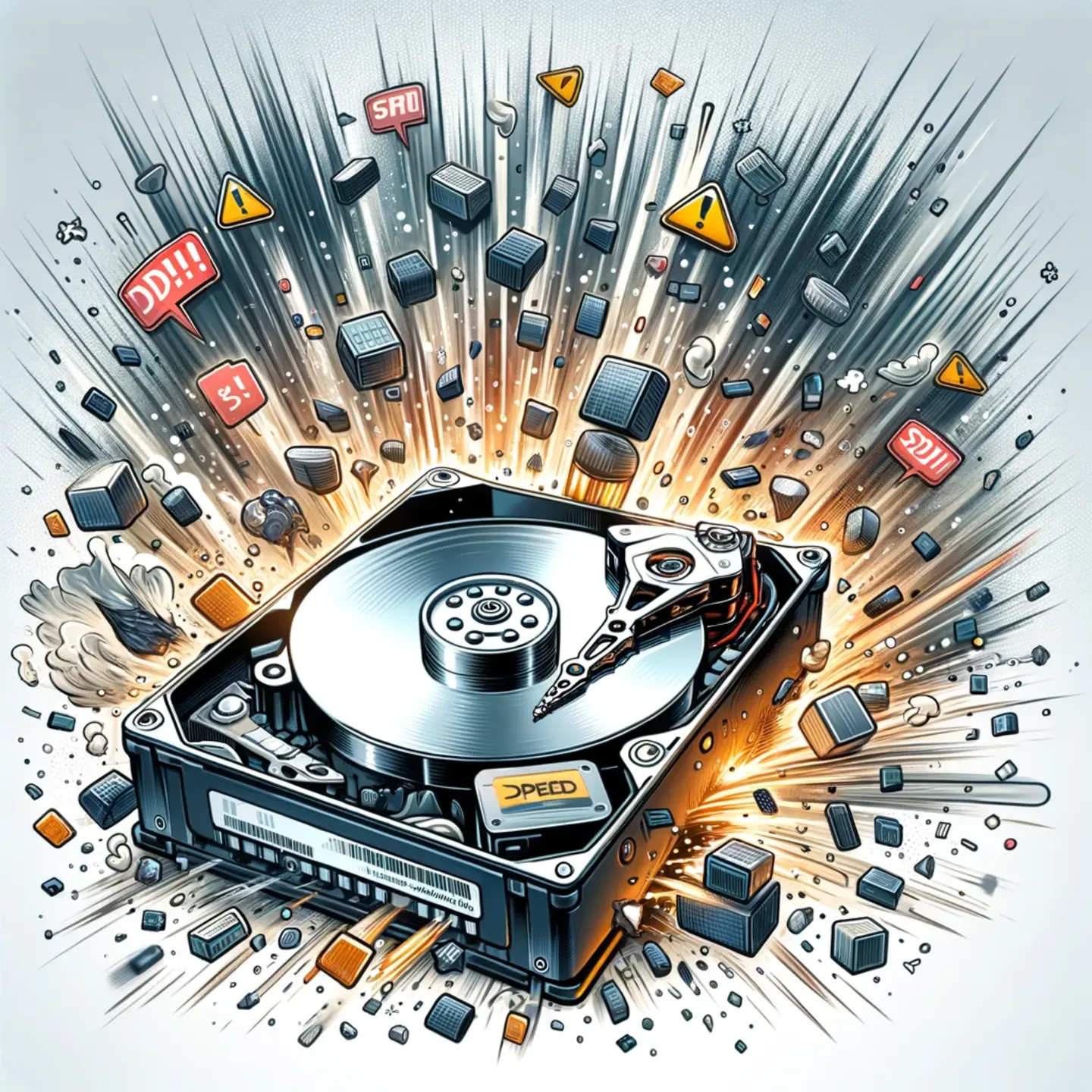What is Disk Thrashing?
 Disk thrashing is a performance degradation phenomenon observed in computer systems when the hard drive is overworked by constantly reading and writing data. In organizational data storage contexts, this becomes particularly critical due to the intensive demands of multiple, simultaneous, high-load applications accessing the storage system. Drive thrashing (also known as virtual memory thrashing) occurs when the system’s virtual memory manager becomes overly active, swapping data between physical RAM and disk storage more frequently than is efficient for system performance. This excessive disk activity can significantly slow down the performance of storage systems, leading to bottlenecks in data access and processing.
Disk thrashing is a performance degradation phenomenon observed in computer systems when the hard drive is overworked by constantly reading and writing data. In organizational data storage contexts, this becomes particularly critical due to the intensive demands of multiple, simultaneous, high-load applications accessing the storage system. Drive thrashing (also known as virtual memory thrashing) occurs when the system’s virtual memory manager becomes overly active, swapping data between physical RAM and disk storage more frequently than is efficient for system performance. This excessive disk activity can significantly slow down the performance of storage systems, leading to bottlenecks in data access and processing.
It’s crucial to understand the inherent speed discrepancy between RAM and hard disk storage to grasp the severity of disk thrashing. Compared to RAM, moving a hard disk head takes thousands of times longer. This massive difference means that, eventually, more time is spent swapping the pages in and out of memory than on processing the data. If disk thrashing continues unchecked, it can cause programs to lock up or fail to run, severely disrupting organizational operations and impacting system reliability.
Causes of Disk Thrashing
The primary cause of disk thrashing within organizational environments is the imbalance between the computing resources available and the demands placed on these resources by applications and data processing tasks. Inadequate RAM in a server or storage system forces the operating system to rely heavily on virtual memory. Virtual memory thrashing arises when the system’s attempt to compensate for insufficient RAM by swapping data to and from the disk overwhelms the drive’s capabilities. Additionally, misconfigurations of virtual memory settings, such as excessively small or large paging files, can exacerbate drive thrashing issues. Organizations often run multiple applications simultaneously, with some requiring substantial memory and processing power, further straining the system and precipitating disk thrashing.
Symptoms of Disk Thrashing
In the context of organizational data storage and processing, the symptoms of disk thrashing include notable slowdowns in data retrieval and processing speeds, applications becoming unresponsive, and servers failing to fulfil requests in a timely manner. Monitoring tools may report unusually high levels of disk activity alongside spikes in CPU usage, even when no single application appears to dominate these resources. System administrators might observe that despite adequate processing power, the storage system’s throughput dramatically decreases, indicative of drive thrashing. These symptoms not only impact the efficiency of data operations but also affect the overall productivity of the organization.
Effects of Disk Thrashing
The impact of disk thrashing on organizational data storage systems extends beyond mere performance degradation. It can lead to increased error rates, as the constant read/write operations heighten the risk of data corruption. Over time, the excessive mechanical work involved in drive thrashing can also shorten the lifespan of physical storage media, leading to higher replacement costs and potential data loss incidents. Furthermore, the reduced performance can cause application timeouts and failures, disrupting business operations and potentially leading to significant financial losses.
How to Identify Disk Thrashing
 Identifying disk thrashing within an organizational data storage framework requires a meticulous approach to monitoring and analyzing system performance metrics. IT administrators should utilize advanced monitoring tools designed for enterprise environments to track disk I/O operations, CPU usage, and memory utilization in real time. A significant indicator of disk thrashing is the sustained high disk activity coupled with frequent, excessive swapping of data between RAM and disk storage, often without a corresponding increase in active user operations or application processing load.
Identifying disk thrashing within an organizational data storage framework requires a meticulous approach to monitoring and analyzing system performance metrics. IT administrators should utilize advanced monitoring tools designed for enterprise environments to track disk I/O operations, CPU usage, and memory utilization in real time. A significant indicator of disk thrashing is the sustained high disk activity coupled with frequent, excessive swapping of data between RAM and disk storage, often without a corresponding increase in active user operations or application processing load.
To accurately diagnose drive thrashing, IT professionals must also scrutinize the patterns of resource usage over time. For instance, observing the correlation between peaks in disk activity and specific applications or processes can pinpoint the culprits behind the thrashing. Additionally, logs and system reports should be analyzed for warnings or errors related to memory shortages or virtual memory system stress. Employing these diagnostic strategies allows organizations to not only detect disk thrashing but also understand its impact on their data storage and processing infrastructure.
How to Prevent Disk Thrashing
Preventing disk thrashing in an organizational context involves both immediate remedies and long-term strategies to optimize system performance and reliability. A primary measure is upgrading the physical memory (RAM) of the system to reduce reliance on virtual memory and minimize disk I/O operations. Organizations should assess their memory requirements based on the applications they run and the volume of data processed, ensuring that their systems are equipped with sufficient RAM to handle peak loads efficiently.
Configuring virtual memory settings appropriately is another critical step in preventing virtual memory thrashing. System administrators must ensure that the paging file size is optimized for their specific workload and system capabilities. Implementing best practices for application management, such as limiting the number of concurrent high-memory applications and regularly updating software to eliminate memory leaks or inefficient processing, can also mitigate the risk of disk thrashing.
In addition to these technical measures, fostering a culture of proactive system maintenance and performance optimization within the organization is vital. Regularly reviewing and adjusting system configurations, updating hardware based on performance monitoring insights, and training staff to recognize the signs of potential system stress can prevent disk thrashing from becoming a disruptive issue.
How DataCore Can Help
DataCore SANsymphony offers an advanced solution to the challenges of disk thrashing through its high-speed caching capability, utilizing server RAM as a dynamic performance accelerator. This approach leverages the high-speed capabilities of RAM, avoiding the degradation and wear associated with Flash technology, to significantly enhance application performance. By using DRAM as a read and write cache, SANsymphony effectively pre-fetches anticipated data blocks into the read cache while coalescing random writes into larger sequential transfers. This process not only accelerates I/O response times from existing storage resources but also acts as a speed-matching buffer, thereby mitigating potential bottlenecks in the I/O path and protecting against the excessive thrashing that can occur with traditional spinning disks.
Moreover, SANsymphony’s proprietary caching algorithm supports up to 8 TBs of high-speed cache per node, creating a robust “mega-cache” that can dramatically boost application speed. This solution capitalizes on the affordability and superior performance characteristics of RAM, offering a cost-effective method to enhance storage architecture efficiency across the board. By providing a 3-5x performance improvement and extending the lifespan of traditional storage components, SANsymphony’s high-speed caching ensures that application servers can dedicate more resources to critical tasks, effectively minimizing the impact of disk thrashing and maintaining optimal performance levels within organizational data storage systems.